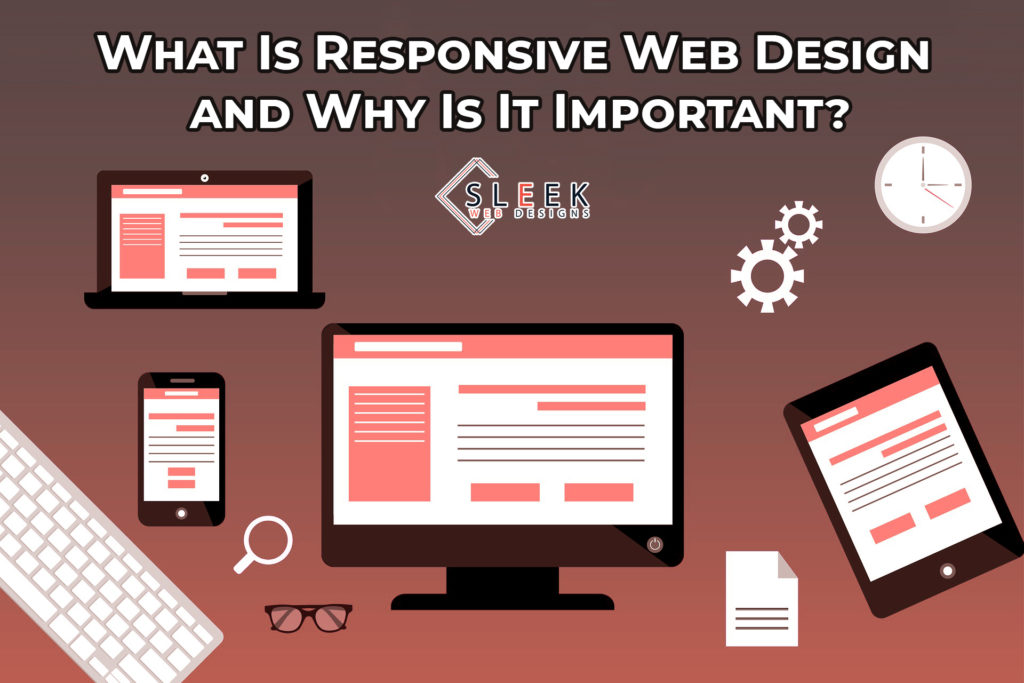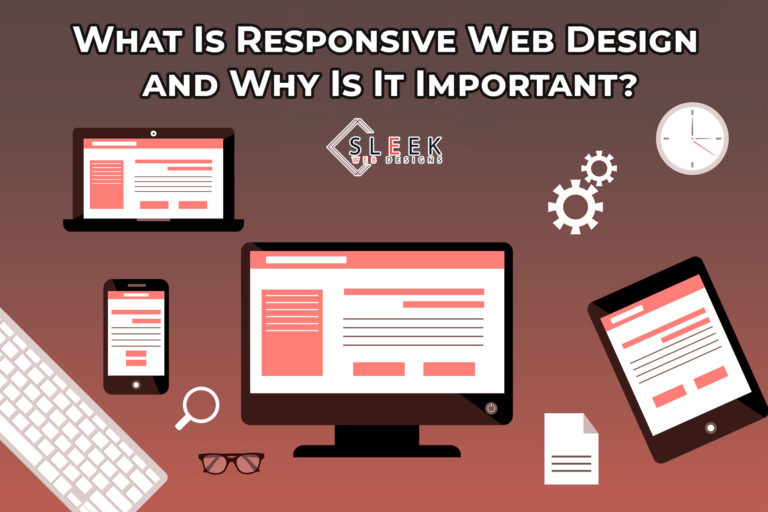|
Getting your Trinity Audio player ready...
|
Last updated on May 12th, 2025 at 10:15 pm
Thank you for reading this post, don't forget to subscribe!
What is responsive web design? Imagine a site that adjusts to your screen regardless of size and gives an optimal experience. Responsive web design makes seemingly minor adjustments to a website, but the final result makes it worthwhile.
It will appropriately and automatically resize, hide, move, or shrink different website elements, like images, videos, words, and buttons, to make the most of the available screen without compromising the user’s experience.
Responsive web design is necessary since people are moving to smaller, more portable devices.
Types of Responsive Designs
Let’s look at the different design approaches that can take a website to the next level.
1. Mobile-first Design
A site may be responsive but not mobile-first. The mobile-first approach proactively prioritizes the mobile user experience.
It involves reducing bulky content, minimizing visual clutter, and ensuring only what’s essential takes center stage. The rest of the features stay hidden in hamburger menus and side panels. You build the design from the smallest screen to the largest, adding components as you go.
2. Responsive Web Design
Responsive design reacts to the screen size presented and fits the content appropriately. It uses media query breakpoints to wrap text, scale images, and adjust layouts.
User experience may not always be the best on different devices, but it’s a great approach. A few tweaks can improve the user experience.
3. Adaptive Web Design
Adaptive design identifies the device size and then adjusts the website to that static layout. It’s best used by websites that may change their look. All resources and efforts go towards the prioritized screen size.
4. Fluid Web Design
The adaptability is the same as that of adaptive and responsive design. The difference lies in not depending on fixed units. It considers the space available and adapts according to percentage.
Everything stays balanced, with enough whitespace on all devices. The site has become user-friendly and has mobile-friendly features.
How To Make Your Website Responsive
1. Use a Fluid Grid
A fluid grid places site elements in proportion to the display screen. It responds and resizes items to fit the browser window appropriately.
The screen is divided into columns where widths and heights are scaled instead of having fixed dimensions. How much text and different elements appear will depend on screen size.
Unlike previous methods where websites used pixel measurements, a fluid grid ensures visual consistency across devices.
2. Set the Right Breakpoints
A breakpoint is the “point” where the website’s design and content adapt to provide the best user experience.
This point is necessary because devices come in different shapes and sizes, and users expect a smooth experience across all of them. All critical content must be visible and not distorted or obscured.
Media query breakpoints or CSS breakpoints ensure the site remains responsive and adjusts accurately according to the display screen.
3. Build with Touchscreens In Mind
There are so many devices with touchscreens, including phones, tablets, and laptops. Accessing websites is a different experience on each of these gadgets.
The elements on a website should be placed at appropriate places depending on the device to enhance the user experience. A drop-down menu, for example, is easy to maneuver on a large screen but would require a slight change to use on a mobile screen.
- Elements must be smaller yet easy to spot and click on when using smaller screens. Larger desktop screens require larger buttons. Consider putting call-to-actions on mobile screens near thumbs to make them easier to see and access.
- Buttons should be big enough to click on based on average thumb size but small enough to look appealing and blend in with the rest of the website.
- Anything that responds to a cursor hovering above it may not be helpful on a touchscreen. It limits what a user can accomplish on the site using a touchscreen device.
Pro-Tip: Always test your site before launch.
Why Should You Test Your Site?
So you’ve implemented all these changes, and your site looks good. Ready to invite the world to enjoy it with you, right? Not quite.
One crucial step before launch is testing. Want to know why?
1. Ensures everything is working properly
What better way to determine if the changes work than to test the site? You can check how the site renders on different devices during the testing phase. You’ll find out whether it meets your visual and potential users’ expectations.
Testing will allow you to use the site to determine whether all the buttons work as expected. You can find out whether you like how it responds to different commands.
You can check all the information provided is correct and easy to find. Your users need to see what they are looking for easily.
It’s also a great time to check on data safety and security. Will your users need to submit any data while using your site? Is it safe in your hands (or servers)? Check for and seal any loopholes before launching.
You’ll get to see all the positives and negatives at this stage. It gives you room to fix anything in the privacy of the offline world.
2. It Makes the business look professional and trustworthy
Trusting a company whose website looks beautiful and works as it should is easier. Since your website may be the first point of contact in this era, make that first encounter count by ensuring the site is up to standard during testing.
3. Brings in quality leads and prospects
People will likely assess your business based on your website. Paying great attention to the small details on your website shows you take care of your clients and deliver as expected, maybe even beyond expectations.
Testing your site will tell you whether your site will bring in the sales leads you’re trying to attract and convert. Test it and watch them roll in.
4. Maintains a positive user experience
Your customers are the most significant part of your business. You must ensure your website caters to their needs and provides a good user experience. Testing will open your eyes from a customer’s perspective.
You want your customers to stay on the site, interacting with your content as long as possible. Google favors responsive websites with a positive user experience, so make sure to provide that.
Benefits of Responsive Design
Responsive web design isn’t just a buzzword. It comes with several benefits to your website and business. Let’s outline some of them below.
1. Improved Page Speed
An optimized, responsive site often loads faster. Nobody wants to wait several minutes for a website to load.
Improved page speeds mean more website traffic and a possible increase in conversions.
2. Improved Customer Experience
Finding everything you need with ease, the site responding to clicks, buttons being easy to click, content being visible without unnecessary clutter, and general ease of use make for an improved customer experience.
Users who enjoy being on your site will likely come back more often. They might even recommend your business to their networks. That’s a plus!
3. Reduced Bounce Rate
Bounce rate refers to the percentage of website visitors who visit only a single page. It means people aren’t staying longer and engaging with your content.
It could be because your site is slow, the content isn’t engaging or valuable, or it didn’t match what users were looking for. Responsive design works on some of these issues, which could keep visitors longer.
4. More Shares on Social Platforms
A responsive site will be easy to use on mobile devices. Since most people live on social media, sharing links across social platforms becomes much more manageable.
More shares mean more mobile traffic and a possible increase in leads and sales. For brick-and-mortar businesses, it could mean more walk-in customers.
5. Eradicated Duplicate Content
You may not start with this motive, but responsive design lets you have a single site for desktop and mobile pages. There’s no need for separate mobile and desktop sites.
Different sites could cause duplicate content issues. Even though the URLs are different, the content often doesn’t change. With a responsive site, duplication goes out the window.
Conclusion
It’s an evolving tech world, and every business needs to adapt. New devices come up every year, and some designs we haven’t seen yet. How do you prepare your business for what’s coming? You go to your clients in the form they’re most comfortable with.Don’t let an unresponsive website lock you out of potential customers’ view. Adjust, adapt, and get a web designer to redesign your website for success across all market segments and devices.





